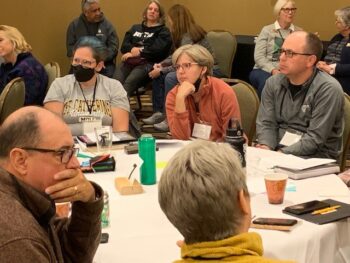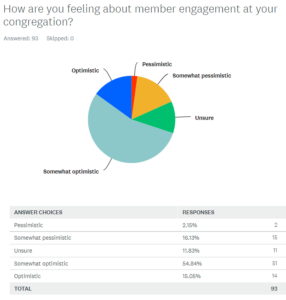By Pastor Craig Pederson
For the first time since the fall of 2019, rostered ministers gathered on the shores of Gull Lake near Brainerd for the 2022 Bishop’s Theological Conference. The theme for this year’s conference was “Facing the Wilderness, Embracing a Path,” focusing on the climate change crisis, environmental racism, and the responses of faith communities.
In the picturesque north woods setting of Grandview Lodge, the conference opened with dinner and evening worship. Over the next two days, participants gathered for thematic devotions, provocative plenary sessions and workshops, relaxing free time, and social time with their peers.

Bishop’s Theological Conference participants listened, learned, prayed, and played together. And, they took a survey.
In addition, attendees were invited to participate in a brief survey to “take the temperature” of the congregations of the synod. After three years of pandemic, social unrest in response to systemic racism, and economic disruptions, congregations and their leaders continue to adapt to evolving challenges. Now, most churches are returning to “normal” fall ministry programming, providing an opportunity to gauge how leaders are feeling about the months ahead.
The survey asked participants to identify the geography and size of their congregations. Then they were asked how they felt about four particular areas of ministry (with options for response being Optimistic, Somewhat Optimistic, Unsure, Somewhat Pessimistic, Pessimistic):
- Worship Attendance
- Member Engagement
- Children’s and Family Ministry
- Church Finances
Lastly, they were invited to respond openly to two questions:
- What is encouraging you?
- What is concerning you?
93 OF THE NEARLY 130 attendees responded to the survey. Here were their aggregate responses:
How are you feeling about worship attendance at your congregation?
70% said “Optimistic” or “Somewhat Optimistic”
How are you feeling about member engagement at your congregation?
Nearly 70% said “Optimistic” or “Somewhat Optimistic”
How are you feeling about Children’s and Family Ministry?

Graphic representation of question on member involvement
57% said “Optimistic” or “Somewhat Optimistic”
How are you feeling about your church’s finances?
Two-thirds (66%) said “Optimistic” or “Somewhat Optimistic”
A closer look at responses based on weekly worship attendance reveals additional insights. For example:
How are you feeling about worship attendance at your congregation?
0 – 50 in worship (21 respondents):
37% “Optimistic” or “Somewhat Optimistic”
24% “Unsure”
38% “Somewhat Pessimistic” (no “Pessimistic”)
51 – 100 in worship (15 respondents):
67% “Optimistic” or “Somewhat Optimistic”
27% “Unsure”
7% “Somewhat Pessimistic” (no “Pessimistic”)
101 – 200 in worship (26 respondents):
85% “Optimistic” or “Somewhat Optimistic”
15% “Unsure”
(no “Pessimistic” or “Somewhat Pessimistic”)
200 – 400 in worship (19 respondents):
84%“Optimistic” or “Somewhat Optimistic”
16% “Unsure” or “Somewhat Pessimistic” (no “Pessimistic”)
Over 400 in worship (10 respondents):
30% “Optimistic”
70% “Somewhat Optimistic”
(no “Unsure” or “Somewhat Pessimistic” or “Pessimistic”)
And looking at another question:
How are you feeling about your church’s finances?
0 – 50 in worship (21 respondents):
48% “Optimistic” or “Somewhat Optimistic”
48% “Pessimistic” or “Somewhat Pessimistic”
51 – 100 in worship (15 respondents):
40% “Optimistic” or “Somewhat Optimistic”
33% “Pessimistic” or “Somewhat Pessimistic”
101 – 200 in worship (26 respondents):
81% “Optimistic” or “Somewhat Optimistic”
11% “Pessimistic” or “Somewhat Pessimistic”
200 – 400 in worship (19 respondents):
100% “Optimistic” or “Somewhat Optimistic” (no “Somewhat Pessimistic” or “Pessimistic”)
Over 400 in worship (10 respondents):
50% “Optimistic” or “Somewhat Optimistic”
20% “Somewhat Pessimistic” (no “Pessimistic” responses)
So, respondents from churches with worship in the middle attendance ranges were most optimistic about worship attendance and church finances, while those with smaller attendance expressed more concern. Large churches (more than 400 in worship) were unanimously optimistic/somewhat optimistic about worship attendance but had concerns about finances.
A BROAD RANGE OF responses were received as participants reflected on what encouraged them and what concerned them. Encouragements centered on renewed energy, reconnection of members, new ideas, strong commitment of those who are showing up, and the work of the Holy Spirit in all of it. Comments included:
- “Working in community. Being community. Congregation wading into Gods future one uneasy step at a time.”
- “The beautiful and Spirit-led possibilities that are emerging.”
- “Real sense of return, energy and excitement”
- “Folks who show up are there because the Spirit sent them. Are excited to be together. Thrilled to eat and serve and worship and all the things.”
Concerns addressed the fatigue of leaders and members, financial uncertainties, aging congregations, racism and patriarchy in the church, polarization, and adapting to changing conditions. Comments included:
- “Fatigue. Huge fatigue. And also division. I’m tired of all of the conversation that feels one sided when we serve churches that are not made up of one-sided people.”
- “The patriarchy. The anxiety of the congregation about finances. The unknown of whether or not families will ever return.”
- “The future of my congregation. I am doing chaplaincy ministry. We are an aging congregation with few workers.”
- “We’re in uncharted waters, and no one knows where we’re headed.”
It should be noted that this survey was not intended to be statistically valid, but instead was just to take a snapshot of opinions at a singular point in time with a certain group of people. Nonetheless, the signs of hope and expressions of concern will likely resonate with leaders beyond just those who were at the Bishop’s Theological Conference.

